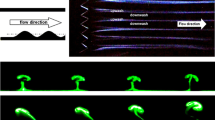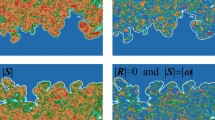Abstract
Compressible Navier–Stokes equations are solved using a fifth-order upwind scheme in the AUSM+ framework to visualize a compressible vortex ring generated from a shock tube. The ring impinges on a wall kept near the open end of the tube. The vortex ring has an embedded shock, counter rotating vortex rings ahead of it and a number of small-scale shear layer vortices trailing behind. When this complex configuration impinges on a wall, wall vorticity is lifted and begins to interact with the complex system of vortices. The paper focusses on the features of the resulting flow field by visualizing them on increasingly finer grids. It is shown that though the different grids capture a fairly matching description of the initial turbulent vortex system that propagates towards the wall, small differences existing between them magnify with time. During vortex–wall interaction, some key experimentally observed features are identified on all the grids, but the details of the vortical structure look significantly different on different grids.
Graphical Abstract
















Similar content being viewed by others
References
Arakeri JH, Das D, Krothapalli A, Lourenco L (2004) Vortex ring formation at the open end of a shock tube: a particle image velocimetry study. Phys Fluids 16(4):1008–1019
Brouillette M, Hébert C (1997) Propagation and interaction of shock-generated vortices. Fluid Dyn Res 21:159–169
Calvo M, Franco JM, Rández L (2004) A new minimum storage Runge–kutta scheme for computational acoustics. J Comput Phys 201:1–12
Chen Z, Yi SH, Tian LF, He L, Zhu YZ (2013) Flow visualization of supersonic laminar flow over a backward-facing step via NPLS. Shock Waves 23:299–306
Drikakis D (2003) Advances in turbulent flow computations using high-resolution methods. Prog Aerosp Sci 39:405–424
Fiorina B, Lele SK (2007) An artificial nonlinear diffusivity method for supersonic reacting flows with shocks. J Comput Phys 222:246–264
Hahn M, Drikakis D (2005) Large eddy simulation of compressible turbulence using high-resolution methods. Int J Numer Meth Fluids 47:971–977
Halder P, De S, Sinhamahapatra KP, Singh N (2013) Numerical simulation of shock-vortex interaction in Schardin’s problem. Shock Waves 23:495–504
Kim KH, Kim C (2005) Accurate, efficient and monotonic methods for multi-dimensional compressible flows part II: multi-dimensional limiting process. J Comput Phys 208:570–615
Kontis K, An R, Zare-Behtash H, Kounadis D (2008) Head-on collision of shock wave induced vortices with solid and perforated walls. Phys Fluids 20(016104):1–17
Liou MS (1996) A sequel to AUSM: AUSM+. J Comput Phys 129:364–382
Mariani R, Kontis K, Gongora-Orozco N (2013) Head on collisions of compressible vortex rings on a smooth solid surface. Shock Waves 23:381–398
Minota T, Nishida M, Lee MG (1997) Shock formation by compressible vortex ring impinging on a wall. Fluid Dyn Res 21:1–17
Murugan T, Das D (2012) Experimental study on a compressible vortex ring in collision with a wall. J Vis 15:321–332
Murugan T, De S, Dora CL, Das D (2011) Numerical simulation and PIV study of compressible vortex ring evolution. Shock Waves 22:69–83
Murugan T, De S, Dora CL, Das D, Kumar PP (2013) A study of the counter-rotating vortex rings interacting with the primary vortex ring in shock tube generated flows. Fluid Dyn Res 45:1–20
Murugan T, De S, Sreevatsa A, Dutta S (2016) Numerical simulation of a compressible vortex-wall interaction. Shock Waves. doi:10.1007i/s00193-015-0611-2
Poinsot TJ, Lele SK (1992) Boundary conditions for direct simulations of compressible viscous flows. J Comput Phys 101:104–129
San O, Kara K (2015) Evaluation of riemann flux solvers for weno reconstruction schemes: Kelvin–helmholtz instability. Comput Fluids 117:24–41
Sun M, Takayama K (2003) A note on numerical simulation of vortical structures in shock diffraction. Shock Waves 13:25–32
Tao Y, Fan X, Zhao Y (2015) Flow visualization for the evolution of the slipstream in steady shock reflection. J Vis 18:21–24
Thornber B, Mosedale A, Drikakis D (2007) On the implicit large eddy simulations of homogeneous decaying turbulence. J Comput Phys 226:1902–1929
Zare-Behtash H, Gongora-Orozco N, Kontis K (2009) Global visualization and quantification of compressible vortex loops. J Vis 12(3):233–240
Zare-Behtash H, Kontis K, Gongora-Orozco N, Takayama K (2010) Shock-wave induced vortex loops emanating from nozzles with singular corners. Shock Waves 49:1005–1019
Acknowledgments
The authors gratefully acknowledge their access to the High-Performance Computing Facility of CSIR-CMERI. In particular, the authors are immensely indebted to Mr. Anupam Sinha, of the Aerosystems Laboratory of the Institute, who has skilfully developed and maintained this facility. We also acknowledge the efforts of Dr. Sarita Ghosh, of the Printing and Publication department, CSIR-CMERI in creating the first figure on experimental comparison.
Author information
Authors and Affiliations
Corresponding author
Rights and permissions
About this article
Cite this article
Kundu, A., De, S., Thangadurai, M. et al. Numerical visualization of shock tube-generated vortex–wall interaction using a fifth-order upwind scheme. J Vis 19, 667–678 (2016). https://doi.org/10.1007/s12650-016-0362-x
Received:
Revised:
Accepted:
Published:
Issue Date:
DOI: https://doi.org/10.1007/s12650-016-0362-x




